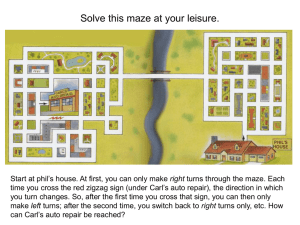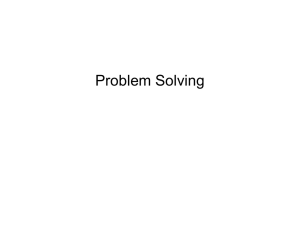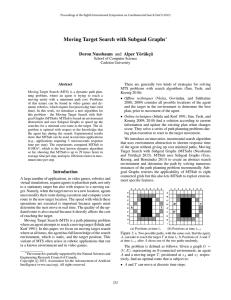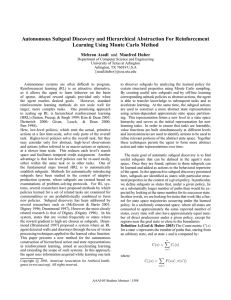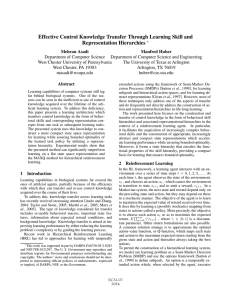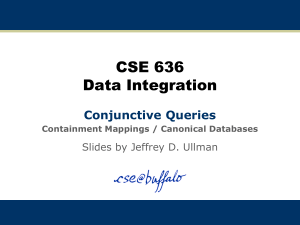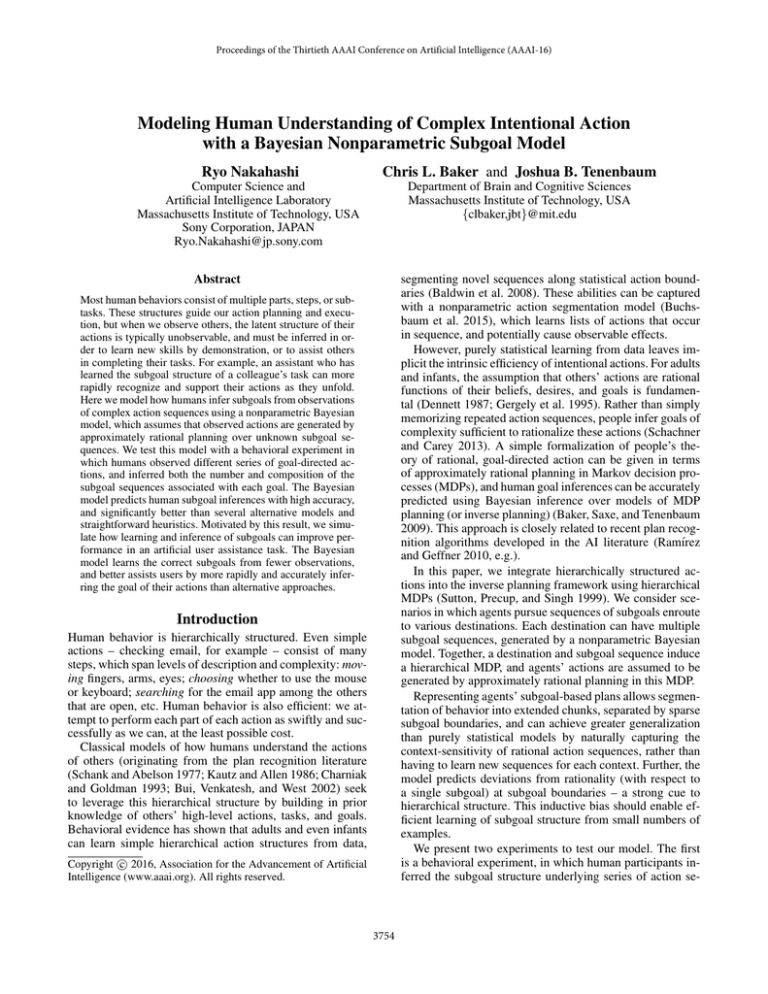
Proceedings of the Thirtieth AAAI Conference on Artificial Intelligence (AAAI-16)
Modeling Human Understanding of Complex Intentional Action
with a Bayesian Nonparametric Subgoal Model
Ryo Nakahashi
Chris L. Baker and Joshua B. Tenenbaum
Computer Science and
Artificial Intelligence Laboratory
Massachusetts Institute of Technology, USA
Sony Corporation, JAPAN
Ryo.Nakahashi@jp.sony.com
Department of Brain and Cognitive Sciences
Massachusetts Institute of Technology, USA
{clbaker,jbt}@mit.edu
segmenting novel sequences along statistical action boundaries (Baldwin et al. 2008). These abilities can be captured
with a nonparametric action segmentation model (Buchsbaum et al. 2015), which learns lists of actions that occur
in sequence, and potentially cause observable effects.
However, purely statistical learning from data leaves implicit the intrinsic efficiency of intentional actions. For adults
and infants, the assumption that others’ actions are rational
functions of their beliefs, desires, and goals is fundamental (Dennett 1987; Gergely et al. 1995). Rather than simply
memorizing repeated action sequences, people infer goals of
complexity sufficient to rationalize these actions (Schachner
and Carey 2013). A simple formalization of people’s theory of rational, goal-directed action can be given in terms
of approximately rational planning in Markov decision processes (MDPs), and human goal inferences can be accurately
predicted using Bayesian inference over models of MDP
planning (or inverse planning) (Baker, Saxe, and Tenenbaum
2009). This approach is closely related to recent plan recognition algorithms developed in the AI literature (Ramı́rez
and Geffner 2010, e.g.).
In this paper, we integrate hierarchically structured actions into the inverse planning framework using hierarchical
MDPs (Sutton, Precup, and Singh 1999). We consider scenarios in which agents pursue sequences of subgoals enroute
to various destinations. Each destination can have multiple
subgoal sequences, generated by a nonparametric Bayesian
model. Together, a destination and subgoal sequence induce
a hierarchical MDP, and agents’ actions are assumed to be
generated by approximately rational planning in this MDP.
Representing agents’ subgoal-based plans allows segmentation of behavior into extended chunks, separated by sparse
subgoal boundaries, and can achieve greater generalization
than purely statistical models by naturally capturing the
context-sensitivity of rational action sequences, rather than
having to learn new sequences for each context. Further, the
model predicts deviations from rationality (with respect to
a single subgoal) at subgoal boundaries – a strong cue to
hierarchical structure. This inductive bias should enable efficient learning of subgoal structure from small numbers of
examples.
We present two experiments to test our model. The first
is a behavioral experiment, in which human participants inferred the subgoal structure underlying series of action se-
Abstract
Most human behaviors consist of multiple parts, steps, or subtasks. These structures guide our action planning and execution, but when we observe others, the latent structure of their
actions is typically unobservable, and must be inferred in order to learn new skills by demonstration, or to assist others
in completing their tasks. For example, an assistant who has
learned the subgoal structure of a colleague’s task can more
rapidly recognize and support their actions as they unfold.
Here we model how humans infer subgoals from observations
of complex action sequences using a nonparametric Bayesian
model, which assumes that observed actions are generated by
approximately rational planning over unknown subgoal sequences. We test this model with a behavioral experiment in
which humans observed different series of goal-directed actions, and inferred both the number and composition of the
subgoal sequences associated with each goal. The Bayesian
model predicts human subgoal inferences with high accuracy,
and significantly better than several alternative models and
straightforward heuristics. Motivated by this result, we simulate how learning and inference of subgoals can improve performance in an artificial user assistance task. The Bayesian
model learns the correct subgoals from fewer observations,
and better assists users by more rapidly and accurately inferring the goal of their actions than alternative approaches.
Introduction
Human behavior is hierarchically structured. Even simple
actions – checking email, for example – consist of many
steps, which span levels of description and complexity: moving fingers, arms, eyes; choosing whether to use the mouse
or keyboard; searching for the email app among the others
that are open, etc. Human behavior is also efficient: we attempt to perform each part of each action as swiftly and successfully as we can, at the least possible cost.
Classical models of how humans understand the actions
of others (originating from the plan recognition literature
(Schank and Abelson 1977; Kautz and Allen 1986; Charniak
and Goldman 1993; Bui, Venkatesh, and West 2002) seek
to leverage this hierarchical structure by building in prior
knowledge of others’ high-level actions, tasks, and goals.
Behavioral evidence has shown that adults and even infants
can learn simple hierarchical action structures from data,
c 2016, Association for the Advancement of Artificial
Copyright Intelligence (www.aaai.org). All rights reserved.
3754
Subgoal sequence likelihood
quences. The second experiment is a simulation to show
that the model is useful in an artificial user support task.
The model first learns the subgoal structure of the task from
a small number of observations. Then, the model infers a
user’s destination and subgoals from a partial action sequence, and attempts to assist the user to achieve a subset of
the remaining subgoals. For each experiment, we compare
the performance of our model with that of several natural
alternatives.
Our hierarchical MDP formulation is closely related to
the options framework for hierarchical reinforcement learning (Sutton, Precup, and Singh 1999). For simplicity, we
assume that actions and state transitions are deterministic,
that each action incurs a cost of 2, that the discount factor
γ = 1.0, and that the destination yields a reward of 100
once all subgoals have been achieved.
The subgoal sequence g is analogous to a set of options,
with initiation and termination conditions that require each
subgoal to be achieved in sequential order. In Fig. 1(a), the
variable g̃t keeps track of the current subgoal at time t. Assume the current subgoal is g̃t = gm ; if the agent reaches
the current subgoal, i.e., st = g̃t , then g̃t+1 ← gm+1 should
be the next subgoal, otherwise the subgoal should stay the
same (g̃t+1 ← g̃t ).
Based on this, an observed sequence s can be divided into
multiple segments corresponding to g. We define boundary
bm to be the first timestep t after gm−1 is achieved: bm =
min({t|st−1 = gm ∧ t > bj−1 }); b0 = 1. We write the
boundary vector b = b0 , b1 , .... If s achieves all subgoals
in g in order, the length of b, dim(b) should be dim(g) + 1.
Otherwise, s does not satisfy g, so P (s|g) should be 0. The
subgoal sequence likelihood is then:
⎧
−1
⎪dim(
g ) bm
⎪
⎪
⎪
P (st+1 |st , gm );
⎨
m=1
t=b
m−1
P (s|g) =
(1)
⎪
⎪
(if dim(b) = dim(g) + 1)
⎪
⎪
⎩
0; (otherwise),
P (st+1 |st , at )P (at |st , gm )
where P (st+1 |st , gm ) =
Computational Model
Fig. 1 represents the structure of our model in terms of separate graphical models for the hierarchical MDP and nonparametric subgoal models. These graphical models specify
the structure of the joint distributions over actions, state sequences, and subgoal sequences. Our model represents the
situational context in terms of a finite state space S. The variable s denotes a state sequence of length T , such that st ∈ S
is the tth state in the sequence. The variable g represents a
sequence of M subgoals. We denote the mth subgoal of g
as gm ∈ S. For convenience, we assume that sT = gM = d
is the destination. We denote the set of actions as A, and the
action executed in st as at ∈ A (see Fig. 1(a)).
The remainder of this section will first define the hierarchical MDP induced by a given destination and subgoal
sequence, and derive the likelihood of a subgoal sequence,
given an observed state sequence. Then we describe the nonparametric model of subgoal sequences, and a Markov chain
Monte Carlo (MCMC) method for jointly inferring the number and composition of the subgoal sequences underlying a
series of action sequences. Finally, we show how to use subgoal sequences learned from previous observations to predict the subgoals and destination of a novel partial action
sequence.
(a) Hierarchical MDP
ࢍ
݃௧ ݏ௧ at ∈A
is the marginal probability of the state transition from
st to st+1 , integrating over actions. P (at |st , gm ) ∝
exp(βQgm (st , at )) is a softmax policy of the local MDP
state-action value function for subgoal gm , based on the assumption that the observed agent plans approximately rationally, stochastically maximizing expected reward and minimizing cost.
A similar likelihood computation was used by (Michini,
Cutler, and How 2013) within an MCMC method for inferring subgoal sequences from user demonstrations. However, this approach focused on learning only one subgoal sequence from one action sequence; in the next section, we
describe a nonparametric Bayesian model and MCMC methods for inferring multiple subgoal sequences, given a series
of state sequences.
(b) Subgoal DP
ߙ
ܲ ݖ ࢍ ݃௧ାଵ ݏ௧ାଵ ܽ௧ାଵ ܽ௧ ߚ
݇ λ
࢙ ܰ
Nonparametric subgoal inference
Figure 1: Graphical models for our framework. (a) Hierarchical MDP planning model of state sequences. Agents select actions according to a probabilistic policy in the hierarchical MDP defined by the subgoal sequence g. β is a
parameter for soft-max action selection. (b) The Bayesian
nonparametric subgoal model takes the form of a Dirichlet
process (DP), in which each action sequence depends on a
goal sequence sampled from a DP with concentration parameter α.
We now consider inference of subgoal structure by observing multiple sequences for a certain destination. We denote
the set of N behavior sequences as s1:N and the ith sequence as si . We denote a set of K subgoal sequences as
g 1:K , and the kth sequence as g k . The problem of nonparametric subgoal inference is to compute P (g 1:K |s1:N ) for an
unbounded number of sequences K.
We model the set of unknown subgoal sequences using
a nonparametric Bayesian model, which allows us to con-
3755
sider an unbounded number of subgoal sequences for each
destination. We use the Dirichlet process (DP) to express
the distribution over subgoal sequences, following (Buchsbaum et al. 2015). A graphical model of our DP model is
shown in Fig. 1(b). We use the Chinese Restaurant Process
(CRP) representation to efficiently draw samples from the
DP. First, the CRP selects a “table” for each observation si ,
conditioned on all previous table assignments and the concentration parameter α0 . zi is the index of the table assigned
to state sequence si . Next, for each CRP table, a subgoal
sequence is sampled from the base distribution P0 , and g k
denotes the subgoal sequence associated with the kth table.
The state sequence si is then generated given its associated
subgoal sequence.
We use a MCMC method to compute the posterior probability over subgoal sequences, specifically, Gibbs sampling.
Gibbs sampling allows us to approximate the complex DP
distribution by inducing a Markov chain over samples from
the CRP. Gibbs sampling over the CRP is a standard MCMC
algorithm for DP inference (Neal 2000). Algorithm 1 is an
overview of our algorithm. As an initialization step, we assign a different table for each state sequence, and draw subgoal sequences from the conditional distribution over subgoal sequences given the state sequence assigned to each
table. We then repeat the table re-assignment step (resampling the table for each state sequence) and the parameter
re-assignment step (drawing the subgoal sequences from the
conditional distribution over subgoal sequences, given all
sequences assigned to a table). For the table re-assignment
step, we calculate the probability P (zi = k|z−i , si ) to assign sequence si to table k according to standard Gibbs sampling for the CRP:
At the end of each step of the loop, we count the number of subgoal sequences for each state sequence. We represent the number of times that g is assigned any state sequence as c(g). The normalized count corresponds to P (g ∈
g 1:K |s1:N ).
Algorithm 1 Subgoal inference
for i = 1 to N do
zi = i; g i ∼ P (g i |si ) // Initialize Step (See, Eq. 1)
end for
for r = 1 to repeat do
for i = 1 to N do
zi ∼ P (zi |z−i , si ) // Table Re-assign Step (See, Eq.
2)
if zi is index for new table then
g zi ∼ P (g zi |si ) // Parameter Initialize for new
table (See, Eq. 1)
end if
end for
for k ∈ {z1 , z2 , ...} do
g k ∼ P (g k |{si |1 ≤ i ≤ N, zi = k}) // Parameter
Re-assign Step (See, 3)
end for
for k ∈ {z1 , z2 , ...} do
c(g k ) ← c(g k ) + 1
end for
end for
for all {g|c(g) > 0} do
P (g ∈ g 1:K |s1:N ) ← c(g)/(repeat)
end for
output P (g ∈ g 1:K |s1:N )
P (zi = k|z−i , si ) =
⎧ n
−i,k
⎪
P (si |g k )
⎪
⎪
N
−
1+α
⎪
⎪
⎨(If k = zj for some i = j)
(2)
α
⎪
P
(s
|g)P
(g)dg
⎪
i
0
⎪
⎪
N −1+α
⎪
⎩
(If k = zj for all i = j),
where z−i denotes table assignments, excluding sequence i,
and n−i,k denotes the number of sequences assigned to table
k, excluding sequence i.
However, for our problem, P (si |g) is the MDP likelihood
of a subgoal sequence. Because this is a non-conjugate distribution, we cannot integrate this equation analytically. If
the environment is small, we can enumerate all of g, and
compute it directly as in the previous section. In large environments we must use an approximate method to choose a
new table; some techniques are described by (Neal 2000). In
the parameter re-assignment step, we draw the subgoal sequence from the posterior over subgoal sequences, given all
sequences assigned to a table. Assume s1:l are the sequences
assigned to table k. The distribution to draw a new subgoal
sequence g for table k should be P (g|s1:l ). This probability
for each subgoal sequence can be calculated as follows:
l
P (g|s1:l ) ∝ P0 (g)P (s1:l |g) = P0 (g)
P (si |g)
(3)
Experiments
Our two experiments presented a “warehouse” scenario involving the delivery of various items to destinations in the
environment shown in Fig. 2. The warehouse has three delivery destinations: A, B, and C. There are nine potential
items to be delivered, marked by numbers 1-9. The items
are arranged into three rows, and for each delivery, one item
can be delivered from each row.
Each job in the warehouse has a specific destination, and
several possible “item lists” to deliver. An item list consists of either one, two, three items that must be delivered
to the destination. For each delivery, one of these item lists
is selected by the warehouse scheduler. In addition to items
from the current item list, workers are encouraged to pick
up “Add-on” items , but only if this won’t increase the number of steps on their path to the destination. For example, if
the item list for Fig. 2(b) is [2,8], item 5 is a good Add-on
item for that delivery, because item 5 is the only additional
item that does not require additional steps to obtain, given
the start point, item list, and destination. There is a direct
correspondence between delivery destinations and item lists
in this setting and destinations and subgoals as represented
by our model.
i=1
3756
(a) Warehouse
environment
(b) Example
sequence
To explain each alternative model, we consider the case in
which the model observes N sequences s1:N .
The Independent model is most similar to our approach.
The only difference is that this model does not use the
CRP, but instead calculates the posterior for each sequence
P (g i |si ) independently. The joint probability for all seN
quences is given by: P (g 1:N |s1:N ) = i=1 P (g i |si ). The
marginal probability for
each subgoal sequence is given by:
P (g ∈ g 1:N |s1:N ) = {g |g ∈g } P (g 1:N |s1:N ).
1:N
1:N
The Logical possibility model is a more heuristic approach, which computes the proportion of observations in
which a subgoal sequence is present within the action sequence. Formally, P (g ∈ g 1:K |s1:N ) = |{i|1 ≤ i ≤
N ∧ g ⊂ si }|/N .
The Copy model is the simplest alternative, but perhaps
the most intuitive. It assigns probability 1 to the subgoals
which have the highest likelihood for each observed sequence. In other words, the inferred subgoal sequence is
the maximal subgoal sequence that is included by an observed action sequence. If we represent such a subgoal sequence M axSubgoal(s), the copy model can be written:
P (g ∈ g 1:K |s1:N ) = 1 if g = M axSubgoal(si ) for some
i, otherwise 0.
(c) Worker-Helper
environment
Figure 2: (a) Experimental scenario. A, B, and C mark possible destinations, and numbers 1-9 mark items that workers
must deliver. Red points mark potential starting locations.(b)
Example agent behavior. (c) Environment of Experiment 2.
Green point is the starting location of the Helper.
Experiment 1: Subgoal inference
Participants We recruited participants for this study using
Amazon Mechanical Turk. Participants were 29 adults located in the USA (Male 13, Female 14, Unknown 2). Mean
age was 32 years old.
Results To compare human behavioral results with those
of our models, we compute the proportion of participants
who selected each item list for each trial. Model predictions
were based on the marginal probability that each item list
generated at least one path.
Table 1 compares the correlation of the Bayesian nonparametric subgoal model and our three alternative models
with human inferences. The Bayesian nonparametric model
correlates very strongly with human inferences. The other
models also correlate positively with human inferences, but
all are substantially worse than the Bayesian nonparametric
model.
Procedure First, in a training phase, subjects learned to
perform an example warehouse job to learn the rules of the
scenario. In each trial of the testing phase, participants saw
8 paths for a particular job, and inferred how many item lists
the job had, and which items were on each list.
Stimuli We prepared 22 jobs for the testing phase, including a range of subgoal structures of varying complexity and
difficulty. First were jobs with one item list, involving 1, 2,
or 3 subgoals. Second were jobs with two item lists, involving 1, 2, or 3 subgoals for both item lists, or 1 and 3 subgoals for each item list, respectively. Some jobs presented
two types of action sequences. In one type, the action sequence could reach all subgoals without deviating from the
shortest path to the destination. These cases were difficult in
that they did not provide direct evidence for any subgoal. In
the other type, the action had to make a detour to reach the
subgoal, which provided stronger evidence for that subgoal.
Model
Correlation
CRP
0.973
Independent
0.644
LP
0.267
Copy
0.495
Table 1: Pearson correlation between human inferences and
computational models. LP stands for “Logical Possibility”.
Fig. 3 plots human inferences against the Bayesian nonparametric model predictions for all trials and subgoal sequences. This shows that our model can almost perfectly
predict whether humans will infer that a certain item list is
included in each job. For a small number of trials, humans
are somewhat uncertain whether to include a particular item
list, and the model captures this uncertainty as well.
Finally, we compare our model predictions with human
inferences for two specific jobs. In Fig. 4(a), each path includes item 5, but there are no paths which include only this
item. Humans and the Bayesian nonparametric model infer
that [5] is the most likely subgoal sequence, based on the
systematic deviation from the shortest path to the destination to reach this item. All other models fail in revealing
ways, inferring more item lists than are necessary to explain
the data. In Fig. 4(b), there are two item lists. Although ev-
Modeling In our MDP representation of the environment,
S corresponds to the agent location, and A is the set of
movements (up, left, and right). We used a uniform distribution for the prior over subgoal sequences P0 (g) and set
β = 6. For the nonparametric Bayesian model, we set the
concentration parameter α0 = 0.015. We used 5,000 iterations of Gibbs sampling, with 1,000 steps burn-in time to
reach the stationary distribution.
Alternative models We prepared 3 alternative models to
compare with our Bayesian nonparametric model: Independent model, Logical possibility model, and Copy model.
3757
Figure 3: Scatter plot of human inferences versus Bayesian
subgoal model predictions (r = 0.973).
ery path is an efficient route to the destination, without inferring an item list, humans and our model can infer these
two subgoal sequences correctly by assessing the probability that these items are selected intentionally rather than by
coincidence. Our alternative models once again fail to capture people’s judgments.
Experiment 2: User support using subgoal
inference
Task definition We call this the Worker-Helper Task.
The main environment is the same as in Experiment 1, but
there are two types of agents. One type is Worker, whose
actions are structured identically to those presented in Experiment 1. The Worker’s job remains the same: to deliver
an item list to a destination. The other type is Helper, which
must support Workers in achieving their goals. The task of
the Helper is to learn the structure of the Worker’s jobs, then
use this to help the Worker complete a job in progress by
retrieving an item from the item list of the Worker, and delivering it to the destination. Helpers begin each trial on the
left side of the warehouse, midway between the second row
of items (4, 5 and 6) and the third row of items (7, 8 and
9). Fig. 2(c) illustrates this task, with the start point of the
Helper marked by a green dot.
Figure 4: Example results for two jobs. (a) Job with item
list [5]; humans and CRP model infer [5] is the most probable subgoal sequence. Alternative models fail to predict human judgments. (b) Job with two item lists: [1] and [3]. Humans and CRP model correctly infer these two subgoal sequences. Once again, the alternative models fail to predict
human judgments.
Collaboration protocol On each trial, the Worker randomly chooses a destination (A, B, or C) and an item list associated with that destination. The set of item lists for each
destination is fixed and known to the Worker, but not the
Helper. Next, the Worker plans a path to achieve their goals
and begins to move through the warehouse. The Helper observes the Worker’s behavior and decides which target item
to retrieve by inferring the Worker’s subgoal sequence (due
to the Helper’s starting location, the target item will always
be in the third row, i.e., item 7, 8, or 9). Once the Helper
decides their target item, the Helper shows this target to the
Worker and begins to move. After the Worker observes the
Helper’s target item, the Worker re-plans its path under the
assumption that the Helper will get the target item. After
the Helper gets the target item, the Helper moves toward the
destination inferred by observing the Worker’s path. When
the Helper cannot decide on a target item, they do nothing.
Modeling We assume that workers take the optimal actions, given their subgoal sequence, i.e., at =
∗
arg max Qπg (st , at ). The Helper estimates the marginal
at
probability that each item is included in the subgoal sequence which the Worker is currently following. The Helper
computes this probability based on the partial path of the
Worker s1:t , and n previously observed paths s1:n , under
the assumption that the Worker plans approximately rationally, with softmax parameter β = 2. When the probability
of a target exceeds a certain value, the Helper decides on this
item. The Worker then re-plans by removing the target item
and the Helper begins to take optimal actions, as does the
3758
Worker.
Probability of target item and destination The marginal
probability of target item
g , given s1:t and s1:n is:
P (g |s1:t , s1:n ) =
∈
d
{g |g ⊆g } P (s1:t |g, d)P (g
g 1:K |sd1:n ), where sd1:n is the subset of previously observed
paths with destination d. P (g ∈ g 1:K |sd1:n ) is calculated using the subgoal inference method in Section 2. P (s1:t |g, d)
can be computed using Eq. 1, but without the constraint
that dim(g) = dim(g) + 1. The marginal probability of
destination d, given s1:t and s1:n is: P (d|s1:t , s1:n ) ∝
d
g P (s1:t |g, d)P (g ∈ g 1:K |s1:n ).
(a)
Alternative models We use the same alternative models
as in Experiment 1, and a common collaboration protocol
(described above) for each subgoal inference model. We also
add two new models. One is No Helper, which means the
Helper has no subgoal knowledge. As a result, the Helper
does nothing. The other is the Ground Truth model, which
means the Helper knows the correct subgoal. It is a benchmark to measure the benefit of the Bayesian model.
((b)
Figure 5: Model scores (a) and variance (b) as a function of
the number of input sequences. Variance of No helper and
Ground Truth is always 0.
Test method We tested three natural types of subgoal settings. In the first, each of the three destinations has one subgoal sequence, which consists of either 7, 8, or 9. In the
second, each of the three destinations has one subgoal sequence, which consists of either item 4, 5, or 6 and either
item 7, 8, or 9. In the third, each of the three destinations has
two subgoal sequences which consist of either item 7, 8, or
9. We generate every possible combination of items for each
subgoal setting, then we learn many subgoal structures and
evaluate the performance for each subgoal structure.
subgoal setting (we repeated the experiment 5 times for each
subgoal setting; this score is the variance of these). None of
the alternative models can provide stable user support. In
contrast, the nonparametric Bayesian model provides stable
support using even a small number of input sequences (over
two input sequences). This stability is a key factor for user
support, since unstable help can confuse and frustrate users.
Conclusion
Evaluation for one subgoal structure We generate a
number of sequences of Workers from random start points
for each destination. We then compute subgoal inferences
for each model using the sequences. We then execute the
collaborative task 99 times for each subgoal inference (11
points times 9 trials), and evaluate the performance of Workers in achieving their destination. We repeat these tests 5
times for each subgoal structure. We use the following score
to measure performance. If the Worker achieves their goal,
they score 100 points, but each action costs 2 points. This
directly corresponds to the MDP reward and cost settings in
Experiment 1.
We presented a model of how humans infer subgoals from
observations of complex action sequences. This model used
rational hierarchical planning over subgoal structures generated by a nonparametric Bayesian model to capture people’s intuitions about the structure of intentional actions. We
showed how Bayesian inference over this generative model
using a novel MCMC method predicts quantitative human
subgoal inferences with high accuracy and precision. We
then showed that our model is useful in practice, enhancing
performance in an application to an artificial user support
task.
Our modeling and experimental scenarios are extremely
simplistic in comparison with real human behavior. One limitation is our assumption that subgoal sequences are chosen
according to probabilities determined by the Dirichlet Process. More generally, the probability of choosing a particular subgoal sequence will depend on the efficiency of that
subgoal sequence, relative to the alternatives. To enhance
the expressiveness of our model, Infinite PCFGs (Liang et
al. 2007), Adaptor Grammars (Johnson, Griffiths, and Goldwater 2007), or fragment grammars (ODonnell 2015) are
promising extensions to the simple Dirichlet Process we employ. These and other frameworks which can be applied to
structured goal representation complement our work here by
Results We executed the test, varying the number of input sequences to evaluate the dependence of each model
on the amount of input data. Fig. 5(a) shows the average
score of each model as a function of the number of input sequences. Generally, the Helper using the nonparametric Bayesian model is more beneficial than any alternative
model. This model achieves good performance (almost as
high as the Ground Truth model) using even a small number
of input sequences.
Further, because the alternative models depend highly on
the input sequences, the scores of these models are unstable.
Fig. 5(b) shows the average variance of the results for each
3759
Schachner, A., and Carey, S. 2013. Reasoning about irrational actions : When intentional movements cannot be
explained , the movements themselves are seen as the goal.
Cognition 129(2):309–327.
Schank, R. C., and Abelson, R. P. 1977. Scripts, Plans,
Goals, and Understanding: An Inquiry Into Human Knowledge Structures. Lawrence Erlbaum Associates, Hillsdale,
NJ.
Sutton, R. S.; Precup, D.; and Singh, S. 1999. Between
MDPs and semi-MDPs: A framework for temporal abstraction in reinforcement learning. Artificial Intelligence 112(12):181–211.
naturally interfacing with models of hierarchical planning
analogously to the model we describe.
Acknowledgments
This work was supported by the Center for Brains, Minds
& Machines (CBMM), funded by NSF STC award CCF1231216, and by NSF grant IIS-1227495.
References
Baker, C. L.; Saxe, R.; and Tenenbaum, J. B. 2009. Action
understanding as inverse planning. Cognition 113:329–49.
Baldwin, D.; Andersson, A.; Saffran, J.; and Meyer, M.
2008. Segmenting dynamic human action via statistical
structure. Cognition 106(3):1382–1407.
Buchsbaum, D.; Griffiths, T. L.; Plunkett, D.; Gopnik, A.;
and Baldwin, D. 2015. Inferring action structure and
causal relationships in continuous sequences of human action. Cognitive Psychology 76:30–77.
Bui, H. H.; Venkatesh, S.; and West, G. 2002. Policy Recognition in the Abstract Hidden Markov Model. Journal of
Artificial Intelligence Research 17:451–499.
Charniak, E., and Goldman, R. 1993. A Bayesian model of
plan recognition. Artificial Intelligence 64(1):53–79.
Dennett, D. C. 1987. The Intentional Stance. MIT Press,
Cambridge, MA.
Gergely, G.; Nádasdy, Z.; Csibra, G.; and Bı́ró, S. 1995.
Taking the intentional stance at 12 months of age. Cognition
56(2):165–193.
Johnson, M.; Griffiths, T. L.; and Goldwater, S. 2007. Adaptor grammars: A framework for specifying compositional
nonparametric Bayesian models. In Advances in Neural Information Processing Systems, 641–648.
Kautz, H. A., and Allen, J. F. 1986. Generalized Plan Recognition. In Proceedings of the 5th National Conference on
Artificial Intelligence, 32–37.
Liang, P.; Petrov, S.; Jordan, M. I.; and Klein, D. 2007.
The Infnite PCFG using Hierarchical Dirichlet Processes.
In Proceedings of the 2007 Joint Conference on Empirical Methods in Natural Language Processing and Computational Natural Language Learning, 688–697.
Michini, B.; Cutler, M.; and How, J. P. 2013. Scalable reward learning from demonstration. In Proceedings of the
IEEE International Conference on Robotics and Automation, 303–308.
Neal, R. M. 2000. Markov Chain Sampling Methods for
Dirichlet Process Mixture Models. Journal of Computational and Graphical Statistics 9(2):249–265.
ODonnell, T. J. 2015. Productivity and Reuse in Language: A Theory of Linguistic Computation and Storage.
MIT Press, Cambridge, MA.
Ramı́rez, M., and Geffner, H. 2010. Probabilistic Plan
Recognition Using Off-the-Shelf Classical Planners. In Proceedings of the 24th AAAI Conference on Artificial Intelligence, 1121–1126.
3760

